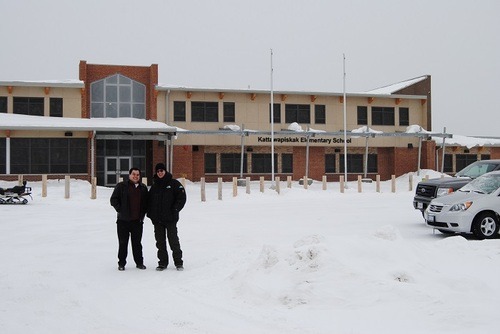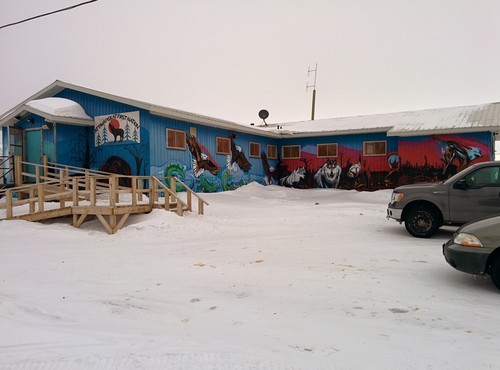
From March 2nd until March 4th, 2015, the Academy of the Impossible was invited by the Western James Bay Telecom Network to visit the Attawapiskat First Nation, located on the then-frozen shores of James Bay, in Northern Ontario. The Western James Bay Telecom Network is a community owned and operated initiative to bring high speed fibre optic Internet to the coastal communities of James Bay. It is backed by the Mushkegowuk Council, which represents eight First Nations in North Eastern Ontario.
On March 3rd, we facilitated six sessions with students and community members around issues arising from using and engaging with the Internet.
These sessions all began with the question: What is the Internet? There are computers, smartphones, tablets, and laptops, but what exactly is the Internet?
One way of looking at the Internet is that it is our imagination. Connecting all these computers and devices has allowed our imagination to be shared, and thus allows us to share ideas, media, stories, and cultures.
Another way of regarding the Internet is as a great big learning curve. After all, the Internet has no finish line, it has no end, and there are always new concepts and services to discover. Thus the Internet is an expression of our ability to learn, and continue learning, whatever it is that interests us.
In meeting with members of the community, especially the younger members/students, it was clear that there is already a tremendous amount of knowledge in the community about the Internet, and the potential for the Internet to empower and enable the people of Attawapiskat in many ways.
The following five suggestions arise from several days of discussion, and focus on how the existing knowledge within the community can be further developed and shared.
1. Community Internet Circle
The Internet will continue to have an impact on society, and the best way for individuals and communities like Attawapiskat to benefit from that impact is to make an active effort to share the knowledge that they collect as individuals with the community as a whole.
The easiest and perhaps most effective way to accomplish this is by having a regular circle to discuss stories and issues that relate to using the Internet and its many applications, services, and games. This could be as simple as a regularly scheduled monthly meeting, where interested members of the community show up to talk about their experiences with the Internet. The purpose of the circle is not to judge, but to share and help each other understand how the Internet is changing our relationship with society (and maybe with each other).
Responsible and safe use of the Internet comes from sharing experience and knowledge about best practices, however it also comes from an open mind that not everyone uses the Internet in the same manner. If and when conflicts do arise (whether online, or offline due to online activity), the principles of restorative justice might be employed to ensure that learning and conflict resolution become the primary outcomes of any dispute.
We cannot blame technology for the changes that it inspires, but we do have to take responsibility for our own actions and communities, and the way in which we choose to use these tools that are becoming available to us.
2. A HackLab
Technology in our era changes very rapidly, as there are always new inventions and devices, like smartphones, tablets, flying robots (drones), and other gadgets.
Having a technology-focused community centre (a HackLab) is an efficient and effective way to ensure that as new technologies emerge, the knowledge of how to use and maintain them responsibly is shared as widely as possible.
A HackLab could exist inside of a school, athletic complex, or even as a distinct space. However the goal of such a lab is to give a home to both the technology and the curious individuals who wish to experiment, play, and wrestle with the ways in which it could have an impact on the community as a whole.
Hackers are hunters who seek knowledge. They head out onto the Internet seeking to learn all that they can about a particular technology. A HackLab is a community centre that provides a place for Hackers to share their knowledge, and for other members of the community to learn how to Hack in a safe and supportive environment.
3. Local Area Networks
Speed on the Internet is relative, and we forget that while we can cross the world in an instant, it will always be faster to access information and services that are closer to home.
Establishing and developing servers and content for local area networks ensures that fast speeds can be possible regardless of uplink connections or the rising popularity of sites like Netflix. These servers could be set up relatively inexpensively using free and open source software such as Linux and Drupal to facilitate capacity-building of community members, as well as encouraging people to interact with each other without having to travel far, and thus take advantage of speeds that are only available on local area networks.
For example, rather than Facebook, the community could have its own local social network, built on free software like Drupal to emulate all the features and capabilities of Facebook, without Facebook’s advertising or agenda.
An open media server could be used to share content and media files. All of which would be available at superfast speeds, and could keep the uplink open for other applications.
A free telephone server such as Asterisk could be used to enable voice mails, teleconferencing, and free local calls.
There are countless additional free applications that could be offered from a local server and local area network, which could themselves be co-ordinated by the local HackLab and Community Internet Circle.
4. Culture and Sovereignty
The Internet is having a profound impact on cultures around the world as it makes it increasingly easy to share culture and media. However, this means that if you’re not actively supporting and sharing your culture online, you may be impacted by the seeming immersion of other cultures. Therefore, it is important that communities make an active and ongoing effort to support and share their own cultures.
The Internet also has a dramatic impact on the notion of sovereignty.
On the one hand, the Internet is decentralized, and if communities take responsibility for their use of the Internet, then there’s no reason why they can’t use it, and govern their part of it, however they wish or deem fit.
On the other hand, the Internet is a force for centralization and automation, allowing for remote control, and thus the potential disempowerment, if not outright domination, of a community.
It is imperative that communities actively support their culture and exercise their sovereignty. Use it or lose it. Share it or forget about it.
5. Crowdfunding
Communities tend to rely upon crowdfunding in various forms to support numerous local initiatives, sport teams, and causes. Whether via Bingo, raffles, bake sales, or lotteries, crowdfunding is not a new phenomenon. But the way in which the Internet is enabling this kind of fundraising to evolve is worth further investigation.
In particular, crowdfunding on the Internet does not have to be limited to the physical community, but gives access to larger and broader networks both geographically and based on affinity and interest. What you ask for and who you ask has become a greater variable for communities seeking to find financial support.
Websites like KickStarter.com, Indiegogo.com, and Patreon.com have provided dynamic platforms for people to raise money for their projects, ideas, causes, and organizations.
More info:
http://www.pathoftheelders.com/index.php

Photos by Dave Wheesk

